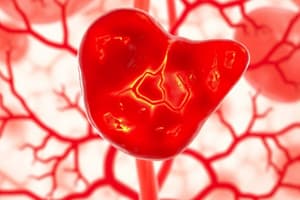Podcast
Questions and Answers
What type of toxicity is primarily associated with the chlorinated hydrocarbon DDT?
What type of toxicity is primarily associated with the chlorinated hydrocarbon DDT?
- Neurotoxicity. (correct)
- Pulmonary toxicity.
- Hepatotoxicity.
- Renal toxicity.
Which factor does NOT contribute to the liver's role in hepatotoxicity?
Which factor does NOT contribute to the liver's role in hepatotoxicity?
- Its location in the body preventing certain toxins from entering. (correct)
- Its position at the end of the portal system.
- The large blood supply it receives.
- The presence of bile secretion increasing drug toxicity.
What characteristic makes specialized organs like the central nervous system (CNS) more susceptible to disruption?
What characteristic makes specialized organs like the central nervous system (CNS) more susceptible to disruption?
- Their capacity for detoxification.
- Their large size relative to other organs.
- Their ability to quickly repair injuries.
- Their highly specialized function and structure. (correct)
What is the primary consequence of iNOS induction in liver cells?
What is the primary consequence of iNOS induction in liver cells?
Which of the following best describes the type of necrosis associated with Acetaminophen and CCl4 toxicity?
Which of the following best describes the type of necrosis associated with Acetaminophen and CCl4 toxicity?
How does the presence of enzymes or compounds like ethanol affect hepatotoxicity from Acetaminophen?
How does the presence of enzymes or compounds like ethanol affect hepatotoxicity from Acetaminophen?
Which cell type plays a significant role in exacerbating Acetaminophen toxicity?
Which cell type plays a significant role in exacerbating Acetaminophen toxicity?
What antidote is used to mitigate the effects of Acetaminophen hepatotoxicity?
What antidote is used to mitigate the effects of Acetaminophen hepatotoxicity?
Flashcards are hidden until you start studying
Study Notes
Types of Liver Toxicity
- Toxicant-induced liver injury involves mechanisms leading to cell death or necrosis.
- Acetaminophen and CCl4 toxicity is commonly bio-activated by CYP-450, predominantly causing centrilobular necrosis (Zone 3 where CYP-450 is abundant).
- Co-administration of enzyme inducers like ethanol enhances the toxicity of Acetaminophen and CCl4.
- Activation of Kupffer cells by factors such as Vitamin A or endotoxins exacerbates Acetaminophen toxicity due to intercellular signaling between damaged hepatocytes and activated Kupffer cells.
Mechanisms of Hepatic Necrosis
- N-acetyl-cysteine serves as an antidote for Acetaminophen toxicity by promoting the synthesis of glutathione (GSH).
- Hepatic necrosis is characterized by mitochondrial dysfunction as a result of Peroxynitrite (OONO-) binding to macromolecules like hepatic cell proteins and DNA.
- Key underlying mechanisms include lipid peroxidation, cellular macromolecule binding, mitochondrial damage, and calcium influx.
Target Organ Toxicity
- A target organ is typically the organ most affected by a toxicant, rather than the one responsible for absorption.
- Target organ toxicity results from toxins distributed via the bloodstream or lymphatics, influenced by factors such as blood supply, enzyme abundance, organ function, repair ability, and metabolic activity.
- Chemicals may have multiple target organs; for example, DDT (a chlorinated hydrocarbon) primarily affects the CNS without causing direct toxicity to adipose tissue.
Hepato-toxicity
- The liver is particularly vulnerable to toxic injuries due to its substantial blood supply and position in the portal circulation.
- First organ to encounter ingested substances, the liver significantly interacts with nutrients, metals, and toxins absorbed from the gastrointestinal tract.
- Bile secretion increases toxicity from drugs excreted in bile via enterohepatic circulation.
- Acute necrosis leads to functional liver failure, which is often irreversible.
Patterns of Liver Necrosis
- Focal necrosis involves localized damage to small clusters of hepatocytes.
- Zonal necrosis occurs in specific functional regions of the liver.
- Massive necrosis results in extensive cell death throughout the liver, affecting centrilobular, midzonal, and periportal areas.
Causative Agents of Liver Toxicity
- Known agents that cause necrosis include CCl4, acetaminophen, chloroform, halogenated hydrocarbons, and bromobenzene.
- The mechanism of CCl4 hepatotoxicity primarily leads to fatty liver and centrilobular necrosis due to its lipid solubility and subsequent metabolic activation by CYP-450.
Studying That Suits You
Use AI to generate personalized quizzes and flashcards to suit your learning preferences.




